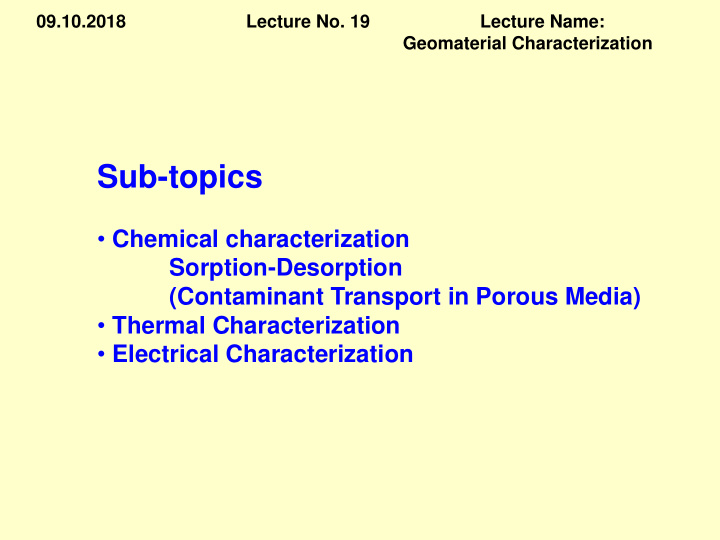



09.10.2018 Lecture No. 19 Lecture Name: Geomaterial Characterization Sub-topics • Chemical characterization Sorption-Desorption (Contaminant Transport in Porous Media) • Thermal Characterization • Electrical Characterization
Contaminant Transport in Porous Media Flow of water through porous media is extensively studied (seepage, consolidation and stability) The concept of hydraulic conductivity are well established. Chemical flows in soils are of great importance. Some important examples are: waste storage, remediation of contaminated sites leaching phenomena, etc. Contaminants are basically dissolved inorganic or organic substances in the solvent (water or fluids). Various concentration units are used to define the relative amounts of contaminants in the solvent: Mass concentration: milligrams of contam. in 1 litre of water (mg/L) Parts per million (ppm): grams of solution/ million grams of solution
Types of Flow through Porous Media If flow does not change the fabric and stress state of the porous media, then flow rate J relates linearly to its corresponding driving force, X: J = . X : conductivity coefficient for flow Chemicals Electricity Heat Fluid H 1 T 1 >T 2 H 2 H C 1 C 2 V 1 V 2 T T 2 1 L L L L J D q q I J D = D C/L I = V/L q = K T/L = k H/L q Fick’s law Ohm’s law Fourier’s law Darcy’s law
Advection (or Convection) Solute (contaminant) gets transported (seepage velocity) t 0 along with the flowing fluid (water) in response to a gradient (hydraulic). V s = k.i/ t 1 If a mass of solute (non reactive) of a concentration C is placed at one end of a pipe, then in a t 2 given time it will travel a certain distance as a Plug due to advection. The transit time required for a non-reactive solute to migrate through a saturated soil of thickness L would be: t = L/V s = .L/(k.i)
Representative values for effective porosity Description Soils GC, GP, GM,GS 0.20 SW,SP,SM,SC - ML, MH 0.15 CL,OL, CH, OH, PT 0.01 Rocks Non fractured rocks 0.15 Fractured rocks 0.0001 The advective mass flux, J, (or the mass flowing through a unit cross sectional area in a unit of time) is: J =v.C=k.i.C C = concentration of the solute (i.e., the mass of solute per unit volume of the mixture).
Diffusion Contaminant at Contaminant • Solutes (contaminants) migrate due to concentration concentration = 0 C 0 at t 0 their chemical activity in the absence of at t 0 bulk fluid flow. • From higher concentration to lower concentration area. • Difference in contaminant concentration is the concentration gradient. Sample • Diffusion ceases when concentration gradient becomes negligible. 1.0 • Relative contaminant concentration C t /C 0 < 1.0 C t / C 0 0.5 =C t /C 0 • Time after introduction of contaminant 0 = t t o t
Diffusion • Add small amount of dye in a fluid • Pulse gets spread out Add continuous dye-- a sharp front
Types of Diffusion • Steady State Diffusion J D =-D. .( C/ x) • Diffusion flux constant with time • Fick’s First law applicable D = diffusion coefficient [L 2 /T] = porosity C/ x = concentration gradient (i.e., change in concentration with distance) • Non Steady-state Diffusion • C x , t C x , t Concentration gradient non-uniform D • Follows Fick’s second law t x x
Chemical Energy Field • To study the mechanism(s) of contaminant transport – the intact and fractured rock samples (Gurumoorthy 2002) diffusion characteristics of the saturated and unsaturated soils (Rakesh 2005) • Investigations using the Cl - , I +2 , Cs +1 and Sr +2 in their active as well as inactive forms • Development of Diffusion Cell
CONTAMINANT TRANSPORT MODELING THROUGH THE ROCK MASS Diffusion cells C 0 C t C t Intact Rock mass (IRM) C o C t Fractured Rock mass (FRM)
CONTAMINANT TRANSPORT MODELING THROUGH THE ROCK MASS Diffusion characteristics Diffusion cells N 33 50 75 100 40 C 0 C t C t Fractured rock mass Intact rock mass 30 -4 ) 0 (x10 Intact Rock mass (IRM) 20 t /C C 10 C o 0 0 2000 4000 6000 8000 10000 0 2000 4000 6000 8000 10000 Time (s) 6 10 Diffusion time (s) Intact rock mass C t 5 Fractured rock mass 10 y=1.8 4 10 Fractured Rock mass t m =t p .N -2 3 (FRM) 10 y=1.97 2 10 7 min. 50 days 6 m thick FRM 1 10 1 10 100 75 min. 520 days 0.3 m thick IRM N (D i ) m =(D i ) p
Modeling Diffusion in soils using impedance spectroscopy (IS) 60 A C U B B 60 A 30 70 Diffusion cell Impedance value of the soil is measured by using LCR meter Diffusion of contaminant can be monitored by determining the change in the impedance of the soil
• Break-through curve 40 (a) 30 -4 ) C t /C 0 (x10 20 10 453 0 0 100 200 300 400 500 t (h) • The slope of the break-through curve diffusion coefficient, D • Archie’s law ( D = . m ) porosity of the geomaterials
Recommend
More recommend